The Formation Age and Magma Source of the Xiaonanshan–Tunaobao Cu-Ni-PGE Deposit in the Northern Margin of the North China Craton
Abstract
:1. Introduction
2. Regional Geology
3. Deposit Geology
4. Petrography
5. Analytical Method
5.1. Zircon U-Pb Dating
5.2. Zircon Lu-Hf Isotope Analyses
5.3. Whole-Rock Major and Trace Elements
5.4. Whole-Rock Sr-Nd Isotopic Compositions
5.5. Sulfur Isotopic Composition
6. Results
6.1. Zircon U-Pb Geochronology
6.2. Zircon Hf Isotope
6.3. Whole-Rock Major and Trace Elements
6.4. Sr-Nd Isotopes
6.5. Sulfur Isotope Geochemistry
7. Discussion
7.1. Age of the XNS-TNB Pluton
7.2. Petrogenesis
7.3. Source of Sulfur
7.4. Tectonic Setting
8. Conclusions
Author Contributions
Funding
Data Availability Statement
Acknowledgments
Conflicts of Interest
References
- Naldrett, A.J. Magmatic Sulfide Deposits: Geology, Geochemistry and Exploration; Springer: Berlin/Heidelberg, Germany, 2004; pp. 1–17. [Google Scholar]
- Tang, Z.L.; Yan, H.Q.; Jiao, J.G.; Li, X.H. New classification of magmatic sulfide deposits in China and ore-forming processes of small intrusive bodies. Miner. Depos. 2006, 25, 1–9, (In Chinese with English Abstract). [Google Scholar]
- Mao, Y.J.; Qin, K.Z.; Tang, D.M.; Xue, S.C.; Feng, H.Y.; Tian, Y. Multiple stages of magma emplacement and mineralization of eastern Tianshan, Xinjiang: Examplified by the Huangshan Ni-Cu deposit. Acta Petrol. Sin. 2014, 30, 1575–1594, (In Chinese with English Abstract). [Google Scholar]
- Song, X.Y. Current research status and important issues of magmatic sulfide deposits. Miner. Depos. 2019, 38, 699–710, (In Chinese with English Abstract). [Google Scholar]
- Cui, M.M.; Su, B.X.; Wang, J.; Tang, D.M.; Sakyi, P.A.; Moynier, F. Linking Selective Alteration, Mineral Compositional Zonation and Sulfide Melt Emplacement in Orogenic-Type Magmatic Ni-Cu Sulfide Deposits. J. Petrol. 2022, 63, egac043. [Google Scholar] [CrossRef]
- Tang, Z.L.; Li, W.Y. Metallogenic Model and Geological Comparison of Copper-Nickel Sulfide (Platinum-Bearing) Deposits in Jinchuan; Geological Publishing House: Beijing, China, 1995; pp. 1–209, (In Chinese with English Abstract). [Google Scholar]
- Qin, K.Z.; Su, B.X.; Sakyi, P.A.; Tang, D.M.; Li, X.H.; Sun, H.; Xiao, Q.H.; Liu, P.P. SIMS zircon U-Pb geochronology and Sr-Nd isotopes of Ni-Cu-bearing mafic-ultramafic intrusions in Eastern Tianshan and Beishan in correlation with flood basalts in Tarim basin (NW China): Constraints on a CA. 280 MA mantle plume. Am. J. Sci. 2011, 311, 237–260. [Google Scholar] [CrossRef]
- Su, B.X.; Qin, K.Z.; Sakyi, P.A.; Li, X.H.; Yang, Y.H.; Sun, H.; Tang, D.M.; Liu, P.P.; Xiao, Q.H.; Malaviarachchi, P.K. U-Pb ages and Hf-O isotopes of zircons from Late Paleozoic mafic–ultramafic units in the southern Central Asian Orogenic Belt: Tectonic implications and evidence for an Early-Permian mantle plume. Gondwana Res. 2011, 20, 516–531. [Google Scholar] [CrossRef]
- Shu, S.Q.; Pei, R.F.; Xing, B.; Jin, X.; Huang, D.M. The progress in the study of the Noril’sk Cu-Ni-PGE sulfide deposit in Russia. Geol. Bull. China 2015, 34, 1100–1109, (In Chinese with English Abstract). [Google Scholar]
- Li, Y.H.; Duan, C.; Fan, C.F.; Hu, B.; Wu, X.P. Effect of gypsum layer for formation of Ni-Cu-PGE sulfide deposits: A case of Noril’sk ores, Russia. Miner. Depos. 2020, 39, 619–630, (In Chinese with English Abstract). [Google Scholar]
- Peng, R.M.; Zhai, Y.S.; Li, C.S.; Ripley, E.M. The Erbutu Ni-Cu Deposit in the Central Asian Orogenic Belt: A Permian Magmatic Sulfide Deposit Related to Boninitic Magmatism in An Arc Setting. Econ. Geol. 2013, 108, 1879–1888. [Google Scholar] [CrossRef]
- Li, R.P. The Characteristics and Origin of the Xiaonanshan Sulfide-Bearing Gabbro, Inner Mongolia. Master’s Thesis, China University of Geosciences, Beijing, China, 2014. (In Chinese with English Abstract). [Google Scholar]
- Jiao, J.G.; Xu, M.C.; Zhou, J.D.; Yan, X.Y.; Ma, Y.F.; Duan, J.; Wang, J.X.; Gao, D. Petrogenesis and metallogenic process of the Kebu magmatic Cu-Ni sulfide deposit in the central Inner Mongolia. Acta Petrol. Sin. 2023, 39, 1125–1143, (In Chinese with English Abstract). [Google Scholar] [CrossRef]
- Zhou, Z.G.; Wang, G.S.; Zhang, D.; Gu, Y.C.; Zhu, W.P.; Liu, C.F.; Zhao, X.Q.; Hu, M.M. Zircon ages of gabbros in the Siziwangqi, Inner Mongolia and its constrain on the formation time of the Bayan Obo Group. Acta Petrol. Sin. 2016, 32, 1809–1822, (In Chinese with English Abstract). [Google Scholar]
- Dang, Z.C.; Li, J.J.; Fu, C.; Tang, W.L.; Liu, Y.; Zhao, Z.L.; Wu, X.Y.; Sun, H.W. Geochronological, Mineralogical and Lithogeochemical Studies of the Kebu Mafic-ultramafic Intrusion in Urad Middle Banner, Inner Mongolia. Acta Geol. Sin. 2018, 92, 278–297, (In Chinese with English Abstract). [Google Scholar]
- Zhou, Z.G.; Wu, J.W.; Niu, Y.; Wang, G.S.; Wu, C.; Liu, C.F.; Ju, J.C. Geochemistry of the Mesoproterozoic Intrusions, Geochronology and Isotopic Constraints on the Xiaonanshan Cu-Ni Deposit along the Northern Margin of the North China Craton. J. Earth Sci. 2020, 31, 653–667. [Google Scholar]
- Wang, Q. Petrogenesis and Magma Source of Wengeng Amafic-Ultramafc lntrusion, Inner Mongolia, China. Master’s Thesis, China University of Geosciences, Beijing, China, 2010; pp. 5–30, (In Chinese with English Abstract). [Google Scholar]
- Ma, Y.F.; Jiao, J.G.; Guo, T.M.; Yan, X.Y.; Liu, J.; Gao, C.; Wang, J.; Li, F. Petrogenesis and mineralization potentials of mafic-ultramafic intrusions in the Xiaonanshan region, Siziwangqi, Inner mongolia. Acta Geol. Sin. 2022, 96, 4312–4330, (In Chinese with English Abstract). [Google Scholar]
- Ni, Z.; Zhai, M.; Wang, R.; Tong, Y. Late Paleozoic retrograded eclogites from within the northern margin of the North China Craton: Evidence for subduction of the Paleo-Asian ocean. Gondwana Res. 2006, 9, 209–224. [Google Scholar] [CrossRef]
- Liu, Y.J.; Li, W.M.; Feng, Z.Q.; Wen, Q.B.; Neubauer, F.; Liang, C.Y. A review of the Paleozoic tectonics in the eastern part of Central Asian Orogenic Belt. Gondwana Res. 2017, 43, 123–148. [Google Scholar] [CrossRef]
- Xiao, Q.H.; Liu, Y.; Xu, L.Q.; Ding, X.Z.; Zhang, Y.Q.; Cheng, Y.; Li, Y.; Fan, Y.X.; He, G.Q. Preliminary Study on Geology and Mineralization of the Bayan Obo Ocean Plate. Earth Sci. 2020, 45, 2258–2278, (In Chinese with English Abstract). [Google Scholar]
- Jahn, B.M.; Wu, F.; Hong, D. Important crustal growth in the Phanerozoic: Isotopic evidence of granitoids from east-central Asia. J. Earth Syst. Sci. 2000, 109, 5–20. [Google Scholar] [CrossRef]
- Xiao, W.J.; Windley, B.F.; Huang, B.C.; Han, C.M.; Yuan, C.; Chen, H.L.; Sun, M.; Sun, S.; Li, J.L. End-Permian to mid-Triassic termination of the accretionary processes of the southern Altaids: Implications for the geodynamic evolution, Phanerozoic continental growth, and metallogeny of Central Asia. Int. J. Earth Sci. 2009, 98, 1189–1217. [Google Scholar] [CrossRef]
- Zhang, S.H.; Zhao, Y.; Kröner, A.; Liu, X.M.; Xie, L.W.; Chen, F.K. Early Permian plutons from the northern North China Block: Constraints on continental arc evolution and convergent margin magmatism related to the Central Asian Orogenic Belt. Int. J. Earth Sci. 2009, 98, 1441–1467. [Google Scholar] [CrossRef]
- Li, J.Y.; Zhang, J.; Yang, T.N.; Li, Y.P.; Sun, G.H.; Zhu, Z.X.; Wang, L.J. Crustal Tectonic Division and Evolution of the Southern Part of the North Asian Orogenic Region and Its Adjacent Areas. J. Jilin Univ. 2009, 39, 584–605, (In Chinese with English Abstract). [Google Scholar]
- Cui, Y.L.; Qu, H.J.; Chen, Y.F.; Wang, S. Early Permian rhyolite related to the continental marginal arc on the northern margin of the North China Craton—Evidence of zircon U-Pb dating and geochemical characteristics. Geol. Rev. 2019, 65, 1299–1315, (In Chinese with English Abstract). [Google Scholar]
- Yang, F.; Pang, X.; Li, B.; Chen, J.; Han, J.; Liu, M.; Yang, Z.Z.; Wang, Y.; Shi, Y. Geological, fluid inclusion, HOS-Pb isotope constraints on the genesis of the Erdaogou gold deposit, Liaoning Province. J. Earth Sci. 2021, 32, 103–115. [Google Scholar] [CrossRef]
- Ma, M.Z.; Zhang, Y.X.; Xie, H.Q.; Wan, Y.S. SHRIMP U-Pb dating and LA-ICPMS Hf isotope analysis of detrital zircons from medium- to coarse-grained sandstones of the Bayan Obo Group and Sailinhudong Group and its geological significances. Acta Petrol. Sin. 2014, 30, 2973–2988, (In Chinese with English Abstract). [Google Scholar]
- Liu, T.J.; Liu, Y.J.; Li, W.M.; Gao, F. The characteristics of detrital zircons from the Zhaertai Group and Bayan Obo Group and its implications for the crustal structure of the provenance area. Chin. J. Geol. 2020, 55, 459–486, (In Chinese with English Abstract). [Google Scholar]
- Liu, Y.S.; Hu, Z.C.; Zong, K.Q.; Gao, C.G.; Gao, S.; Xu, J.; Chen, H.H. Reappraisement and refinement of zircon U-Pb isotope and trace element analyses by LA-ICP-MS. Chin. Sci. Bull. 2010, 55, 1535–1546. [Google Scholar] [CrossRef]
- Ludwig, K.R. User’s Manual for Isoplot 3.00: A Geochronological Toolkit for Microsoft Excel. Berkeley Geochronology Center Special Publications: Berkeley, CA, USA, 2003; Volume 4, 72p. [Google Scholar]
- Scherer, E.; Munker, C.; Mezger, K. Calibration of the lutetium-hafnium clock. Science 2001, 293, 683–687. [Google Scholar] [CrossRef] [PubMed]
- Bouvier, A.; Vervoort, J.D.; Patchett, P.J. The Lu–Hf and Sm–Nd isotopic composition of CHUR: Constraints from unequilibrated chondrites and implications for the bulk composition of terrestrial planets. Earth Planet. Sci. Lett. 2008, 273, 48–57. [Google Scholar] [CrossRef]
- Griffin, W.L.; Pearson, N.J.; Belousova, E.; Jackson, S.E.; Achterbergh, E.V.; O’Reilly, S.Y.; Shee, S. The Hf isotope composition of cratonic mantle: LAM-MC-ICPMS analysis of zircon megacrysts in kimberlites. Geochim. Cosmochim. Acta 2000, 64, 133–147. [Google Scholar] [CrossRef]
- Sun, T.; Qian, Z.Z.; He, K. Geochemistry characters of platinum-group elements in the Huangshandong Ni-Cu sulfide deposit, East Tianshan, China. Geochim. Cosmochim. Acta Suppl. 2009, 73, A1292. [Google Scholar]
- Wang, Z.P.; Lv, Y.; Li, H.; Li, Y.J.; Zhou, Y.L.; Li, G.Y.; Yang, G.X. Petrogenesis of Early Carboniferous Alkaline Basalt from the Wusun Mountain: Implications for Tectonic Evolution of the Western Yining Block, NW China. Acta Geol. Sin. (Engl. Ed.) 2021, 95, 1128–1138. [Google Scholar] [CrossRef]
- Zhang, W.; Hu, Z.; Liu, Y. Iso-Compass: New freeware software for isotopic data reduction of LA-MC-ICP-MS. J. Anal. At. Spectrom. 2020, 35, 1087–1096. [Google Scholar] [CrossRef]
- Thirlwall, M.F. Long-term reproducibility of multicollector sr and nd isotope ratio analysis. Chem. Geol. 1991, 94, 85–104. [Google Scholar] [CrossRef]
- Xu, L.; Hu, Z.; Zhang, W.; Yang, L.; Liu, Y.; Gao, S.; Luo, T.; Hu, S.H. In situ Nd isotope analyses in geological materials with signal enhancement and non-linear mass dependent fractionation reduction using laser ablation MC-ICP-MS. J. Anal. At. Spectrom. 2015, 30, 232–244. [Google Scholar] [CrossRef]
- Weis, D.; Kieffer, B.; Maerschalk, C.; Barling, J.; Jong, J.D.; Williams, G.A.; Hanano, D.; Pretorius, W.; Mattielli, N.; Scoates, J.S.; et al. High-precision isotopic characterization of usgs reference materials by tims and mc-icp-ms. Geochem. Geophys. Geosystems 2006, 7, 139–149. [Google Scholar] [CrossRef]
- Chen, L.; Chen, K.; Bao, Z.; Liang, P.; Sun, T.; Yuan, H. Preparation of standards for in situ sulfur isotope measurement in sulfides using femtosecond laser ablation MC-ICP-MS. J. Anal. At. Spectrom. 2017, 32, 107–116. [Google Scholar] [CrossRef]
- Belousova, E.A.; Griffin, W.L.; O’Reilly, S.Y.; Fisher, N.L. Igneous zircon: Trace element composition as an indicator of source rock type. Contrib. Mineral. Petrol. 2002, 143, 602–622. [Google Scholar] [CrossRef]
- Wu, Y.B.; Zheng, Y.F. Mineralogical study of zircon genesis and its constraints on U-Pb age interpretation. Chin. Sci. Bull. 2004, 49, 1589–1604, (In Chinese with English Abstract). [Google Scholar] [CrossRef]
- McDonough, W.F.; Sun, S.S. The composition of the Earth. Chem. Geol. 1995, 120, 223–253. [Google Scholar] [CrossRef]
- Liu, H.B. The Characteristics and Origin of Rapakivi Granites, in Cu-Ni Sulfide Deposits, Xiaonanshan of Siziwangqi, Inner Mangolia province. Master’s Thesis, China University of Geosciences, Beijing, China, 2022. (In Chinese with English Abstract). [Google Scholar]
- Irvine, T.N.; Baragar, W.R.A.F. A guide to the chemical classification of the common volcanic rocks. Can. J. Earth Sci. 1971, 8, 523–548. [Google Scholar] [CrossRef]
- Peccerillo, A.; Taylor, S.R. Geochemistry of Eocene calc-alkaline volcanic rocks from the Kastamonu area, northern Turkey. Contrib. Mineral. Petrol. 1976, 58, 63–81. [Google Scholar] [CrossRef]
- Pearce, J.A.; Thirlwall, M.F.; Ingram, G.; Murton, B.J.; Arculus, R.J.; Van der Laan, S.R. Isotopic evidence for the origin of boninites and related rocks drilled in the Izu-Bonin (Ogasawara) forearc, Leg 125. In Proceedings of the Ocean Drilling Program, Scientific Results; Ocean Drilling Program: College Station, TX, USA, 1992; Volume 125, pp. 237–261. [Google Scholar]
- Puchtel, I.S.; Haase, K.M.; Hofmann, A.W.; Chauvel, C.; Kulikov, V.S.; Garbe-Schönberg, C.D.; Nemchin, A.A. Petrology and geochemistry of crustally contaminated komatiitic basalts from the Vetreny Belt, southeastern Baltic Shield: Evidence for an early Proterozoic mantle plume beneath rifted Archean continental lithosphere. Geochim. Cosmochim. Acta 1997, 61, 1205–1222. [Google Scholar] [CrossRef]
- Polat, A.; Appel, P.W.; Fryer, B.J. An overview of the geochemistry of Eoarchean to Mesoarchean ultramafic to mafic volcanic rocks, SW Greenland: Implications for mantle depletion and petrogenetic processes at subduction zones in the early Earth. Gondwana Res. 2011, 20, 255–283. [Google Scholar] [CrossRef]
- Zhang, H.; Chen, J.; Yang, T.; Hou, Z.; Aghazadeh, M. Jurassic granitoids in the northwestern Sanandaj-Sirjan Zone: Evolving magmatism in response to the development of a Neo-Tethyan slab window. Gondwana Res. 2018, 62, 269–286. [Google Scholar] [CrossRef]
- Hofmann, A.W. Chemical differentiation of the Earth: The relationship between mantle, continental crust, and oceanic crust. Earth Planet. Sci. Lett. 1988, 90, 297–314. [Google Scholar] [CrossRef]
- Taylor, S.R.; McLennan, S.M. The Continental Crust: Its Composition and Evolution; Blackwell Scientific Publications: Oxford, UK, 1985; pp. 1–328. [Google Scholar]
- Neal, C.R.; Mahoney, J.J.; Chazey, W.J., III. Mantle sources and the highly variable role of continental lithosphere in basalt petrogenesis of the Kerguelen Plateau and Broken Ridge LIP: Results from ODP Leg 183. J. Petrol. 2002, 43, 1177–1205. [Google Scholar] [CrossRef]
- Wei, B.; Wang, C.Y.; Li, C.; Sun, Y. Origin of PGE-depleted Ni-Cu sulfide mineralization in the Triassic Hongqiling No. 7 orthopyroxenite intrusion, Central Asian orogenic belt, northeastern China. Econ. Geol. 2013, 108, 1813–1831. [Google Scholar] [CrossRef]
- Jiao, J.G.; Wang, Y.; Qian, Z.Z.; Wang, B.; Lu, H.; Liu, H.; Zheng, P.P. Tentative discussion on rock-forming and ore-forming mechanism of Kalatongke Cu-Ni sulfide deposit and chronology of Kalatongke Y9 intrusion. Miner. Depos. 2014, 33, 675–688, (In Chinese with English Abstract). [Google Scholar]
- Zindler, A.; Hart, S. Chemical geodynamics. Annu. Rev. Earth Planet. Sci. 1986, 14, 493–571. [Google Scholar] [CrossRef]
- Saunders, A.D.; Norry, M.J.; Tarney, J. Fluid influence on the trace element compositions of subduction zone magmas. Philos. Trans. R. Soc. Lond. Ser. A Phys. Eng. Sci. 1991, 335, 377–392. [Google Scholar]
- Saunders, A.D.; Storey, M.; Kent, R.W.; Norry, M.J. Consequences of Plume-Lithosphere Interactions Special Publications; Geological Society: London, UK, 1992; Volume 68, pp. 41–60. [Google Scholar]
- Woodhead, J.D.; Hergt, J.M.; Davidson, J.P.; Eggins, S.M. Hafnium isotope evidence for ‘conservative’ element mobility during subduction zone processes. Earth Planet. Sci. Lett. 2001, 192, 331–346. [Google Scholar] [CrossRef]
- Zhang, Z.H.; Mao, J.W.; Du, A.D.; Pirajno, F.; Wang, Z.L.; Chai, F.M.; Zhang, Z.C.; Yang, J.M. Re-Os dating of two Cu-Ni sulfide deposits in northern Xinjiang, NW China and its geological significance. J. Asian Earth Sci. 2008, 32, 204–217. [Google Scholar] [CrossRef]
- Hoffer, G.; Eissen, J.P.; Beate, B.; Bourdon, E.; Fornari, M.; Cotten, J. Geochemical and petrological constraints on rear-arc magma genesis processes in Ecuador: The Puyo cones and Mera lavas volcanic formations. J. Volcanol. Geotherm. Res. 2008, 176, 107–118. [Google Scholar] [CrossRef]
- Li, W.B.; Huang, Z.L.; Zhang, G. Sources of the ore metals of the Huize ore field in Yunnan province: Constraints from Pb, S, C, H, O and Sr isotope geochemistry. Acta Petrol. Sin. 2006, 22, 2567–2580, (In Chinese with English Abstract). [Google Scholar]
- Zhou, J.X.; Huang, Z.L.; Zhou, M.F.; Li, X.B.; Jin, Z.G. Constraints of C–O–S–Pb isotope compositions and Rb–Sr isotopic age on the origin of the Tianqiao carbonate-hosted Pb–Zn deposit, SW China. Ore Geol. Rev. 2013, 53, 77–92. [Google Scholar] [CrossRef]
- Bao, Z.; Yuan, W.; Yuan, H.; Liu, X.; Chen, K.; Zong, C. Non-matrix-matched determination of lead isotope ratios in ancient bronze artifacts by femtosecond laser ablation multi-collector inductively coupled plasma mass spectrometry. Int. J. Mass Spectrom. 2016, 402, 12–19. [Google Scholar] [CrossRef]
- Jin, Z.G.; Zhou, J.X.; Huang, Z.L.; Luo, K.; Gao, J.G.; Peng, S.; Wang, B.; Chen, X.L. Ore genesis of the Nayongzhi Pb-Zn deposit, Puding City, Guizhou Province, China: Evidences from S and in situ Pb isotopes. Acta Petrol. Sin. 2016, 32, 3441–3455, (In Chinese with English Abstract). [Google Scholar]
- Li, Z.; Ye, L.; Hu, Y.; Huang, Z.; Wei, C.; Wu, T. Origin of the Fule Pb–Zn deposit, Yunnan Province, SW China: Insight from in situ S isotope analysis by NanoSIMS. Geol. Mag. 2020, 157, 393–404. [Google Scholar] [CrossRef]
- Yang, Y. Sulfur Isotope Geochemistry of Metallogenic Belt Typical Deposits in Gangdese of Tibet. Master’s Thesis, Chengdu University of Technology, Chengdu, China, 2012. (In Chinese with English Abstract). [Google Scholar]
- Chaussidon, M.; Robert, F. Lithium nucleosynthesis in the Sun inferred from the solar-wind 7Li/6Li ratio. Nature 1999, 402, 270–273. [Google Scholar] [CrossRef]
- Rollinson, H.R. Using Geochemical Date: Evaluation, Presentation, Interpretation; Longman Publishing Group: New York, NY, USA, 1993; pp. 174–206. [Google Scholar]
- Jiang, S.H.; Nie, F.J.; Liu, Y.F.; Yun, F. Sulfur and lead isotopic compositions of Bairendaba and Weilasituo silver-polymetallic deposits, Inner Mongolia. Miner. Depos. 2010, 28, 101–112, (In Chinese with English Abstract). [Google Scholar]
- Wang, C.Y.; Wei, B.; Zhou, M.F.; Minh, D.H.; Qi, L. A synthesis of magmatic Ni-Cu-(PGE) sulfide deposits in the ∼260 Ma Emeishan large igneous province, SW China and northern Vietnam. J. Asian Earth Sci. 2018, 154, 162–186. [Google Scholar] [CrossRef]
- Duan, J.; Li, C.; Qian, Z.; Jiao, J.; Ripley, E.M.; Feng, Y. Multiple S isotopes, zircon Hf isotopes, whole-rock Sr-Nd isotopes, and spatial variations of PGE tenors in the Jinchuan Ni-Cu-PGE deposit, NW China. Miner. Depos. 2016, 51, 557–574. [Google Scholar] [CrossRef]
- Zhao, Y.; Yang, Y.Q.; Ke, J.J. Origin of Cu-and Ni-bearing magma and sulfide saturation mechanism: A case study of Sr-Nd-Pb-S isotopic composition and element geochemistry on the Huangshannan magmatic Ni-Cu sulfide deposit, Xinjiang. Acta Petrol. Sin. 2016, 32, 2086–2098, (In Chinese with English Abstract). [Google Scholar]
- Li, C.; Zhang, Z.; Li, W.; Wang, Y.; Sun, T.; Ripley, E.M. Geochronology, petrology and Hf–S isotope geochemistry of the newly-discovered Xiarihamu magmatic Ni–Cu sulfide deposit in the Qinghai–Tibet plateau, western China. Lithos 2015, 216, 224–240. [Google Scholar] [CrossRef]
- Xie, W.; Song, X.Y.; Chen, L.M.; Deng, Y.F.; Zheng, W.Q.; Wang, Y.S.; Ba, D.H.; Yin, M.H.; Luan, Y. Geochemistry insights on the genesis of the subduction-related Heishan magmatic Ni-Cu-(PGE) deposit, Gansu, northwestern China, at the southern margin of the Central Asian Orogenic Belt. Econ. Geol. 2014, 109, 1563–1583. [Google Scholar] [CrossRef]
- Cao, Y.; Wang, C.Y.; Wei, B. Magma oxygen fugacity of mafic-ultramafic intrusions in convergent margin settings: Insights for the role of magma oxidation states on magmatic Ni-Cu sulfide mineralization. Am. Mineral. 2020, 105, 1841–1856. [Google Scholar] [CrossRef]
- Wang, S.J.; Xu, Z.Y.; Dong, X.J.; Wang, W.Q.; Li, P.C. Geochemical Characteristics and Zircon U-Pb Age of the Granodiorite-Norite Gabbro in the Northern Margin of the North China Block and Their Formation Mechanism. Earth Sci. 2018, 43, 3267–3284, (In Chinese with English Abstract). [Google Scholar]
- Zhao, L.; Wu, T.R.; Luo, H.L. SHRIMP U-Pb dating, geochemistry and tectonic implications of the Beiqigetao gabbros in Urad Zhongqi area, Inner Mongolia. Acta Petrol. Sin. 2011, 27, 3071–3082, (In Chinese with English Abstract). [Google Scholar]
- Liu, C.F.; Zhou, Z.G.; Zhang, H.F.; Liu, W.C.; Zhang, L. Petrochemical Characteristics and Timing of Wuertagaolemiao Granitoids, Siziwangqi, Inner Mongolia. Miner. Pet. 2011, 31, 34–43, (In Chinese with English Abstract). [Google Scholar]
- Luo, H.L.; Wu, T.R.; Zhao, L. Zicron SHRIMP U-Pb dating of Wuliangsitai A-type granite on the northern margin of the North China Plate and tectonic significance. Acta Petrol. Sin. 2009, 25, 515–526, (In Chinese with English Abstract). [Google Scholar]
- Zhao, X.; Zhou, W.; Fu, D.; Huang, B.; Ge, M. Isotope Chronology and Geochemistry of the Lower Carboniferous Granite in Xilinhot, Inner Mongolia, China. J. Earth Sci. 2018, 29, 280–294. [Google Scholar] [CrossRef]
- Feng, F.; Xu, Z.Y.; Dong, X.J.; Shi, Q.; Wang, S.J.; Li, C.H. Chronology, Geochemistry and Hf lsotope of Granite Porphyry in Wenduermiao-Jining Area, Inner Mongolia and Its Geological Significance. Earth Sci. 2021, 46, 1973–1992, (In Chinese with English Abstract). [Google Scholar]
- Li, K.; Zhang, Z.C.; Feng, Z.S.; Li, J.F.; Tang, W.H.; Luo, Z.W. Two-Phase Magmatic Events during Late Paleozoic in the North of the Central Inner Mongolia-Da Hinggan Orogenic Belt and Its Tectonic Significace. Acta Geol. Sin. 2015, 89, 272–288, (In Chinese with English Abstract). [Google Scholar]
- Luo, H.L.; Wu, T.R.; Zhao, L. Geochemistry and tectonic implications of the Permian I-type granitoids from Urad Zhongqi, Inner Monglia. Acta Sci. Nat. Univ. 2010, 46, 805–820, (In Chinese with English Abstract). [Google Scholar]
- Zhang, Z.; Mao, J.; Cai, J.; Kusky, T.M.; Zhou, G.; Yan, S.; Zhao, L. Geochemistry of picrites and associated lavas of a Devonian island arc in the northern Junggar terrane, Xinjiang (NW China): Implications for petrogenesis, arc mantle sources and tectonic setting. Lithos 2008, 105, 379–395. [Google Scholar] [CrossRef]
- Kovalenko, V.I.; Yarmoluyk, V.V.; Sal’nikova, E.B.; Kozlovsky, A.M.; Kotov, A.B.; Kovach, V.P.; Savatenkov, V.M.; Vladykin, N.V.; Ponomarchuk, V.A. Geology, Geochronology, and Geodynamics of the Khan Bogd alkali granite pluton in southern Mongolia. Geotectonics 2006, 40, 450–466. [Google Scholar] [CrossRef]
- Kovalenko, V.I.; Yarmoluyk, V.V.; Kozlovsky, A.M.; Kovach, V.P.; Sal’nikova, E.B.; Kotov, A.B.; Vladykin, N.V. Two types of magma sources of rare-metal alkali granites. Geol. Ore Depos. 2007, 49, 442–466. [Google Scholar] [CrossRef]
- Yarmolyuk, V.V.; Kovalenko, V.I.; Sal’nikova, E.B.; Kovach, V.P.; Kozlovsky, A.M.; Kotov, A.B.; Lebedev, V.I. Geochronology of igneous rocks and formation of the Late Paleozoic south Mongolian active margin of the Siberian continent. Stratigr. Geol. Correl. 2008, 16, 162–181. [Google Scholar] [CrossRef]
- Shi, G.H.; Miao, L.C.; Zhang, F.Q.; Jian, P.; Fan, W.M.; Liu, D.Y. Emplacement age and tectonic implications of the Xilinhot A-type granite in Inner Mongolia, China. Chin. Sci. Bull. 2004, 49, 723–729. [Google Scholar] [CrossRef]
- Xiao, Q.H. The Ways of Investigation on Granitoids; Geological Publishing House: Beijing, China, 2002; pp. 1–294, (In Chinese with English Abstract). [Google Scholar]
- Zhou, Z.G.; Gu, Y.C.; Liu, C.F.; Yu, Y.S.; Zhang, B.; Tian, Z.J.; He, F.B.; Wang, B.R. Discovery of early-middle Permian Cathaysian flora in Manduhubaolage area, Dong Ujimqin Qi, Inner Mongolia, China and its geological significance. Geol. Bull. China 2010, 29, 21–25, (In Chinese with English Abstract). [Google Scholar]
- Zhao, P.; Chen, Y.; Xu, B.; Faure, M.; Shi, G.; Choulet, F. Did the Paleo-Asian Ocean between North China block and Mongolia block exist during the late Paleozoic? First paleomagnetic evidence from central-eastern Inner Mongolia, China. J. Geophys. Res. Solid Earth 2013, 118, 1873–1894. [Google Scholar] [CrossRef]
- Hong, D.W.; Wang, S.G.; Xie, X.L.; Zhang, J.S. Genesis of positive ε (Nd, t) granitoids in the Da Hinggan MTS: Mongolia orogenic belt and growth continental crust. Earth Sci. Front. 2000, 7, 441–456, (In Chinese with English Abstract). [Google Scholar]
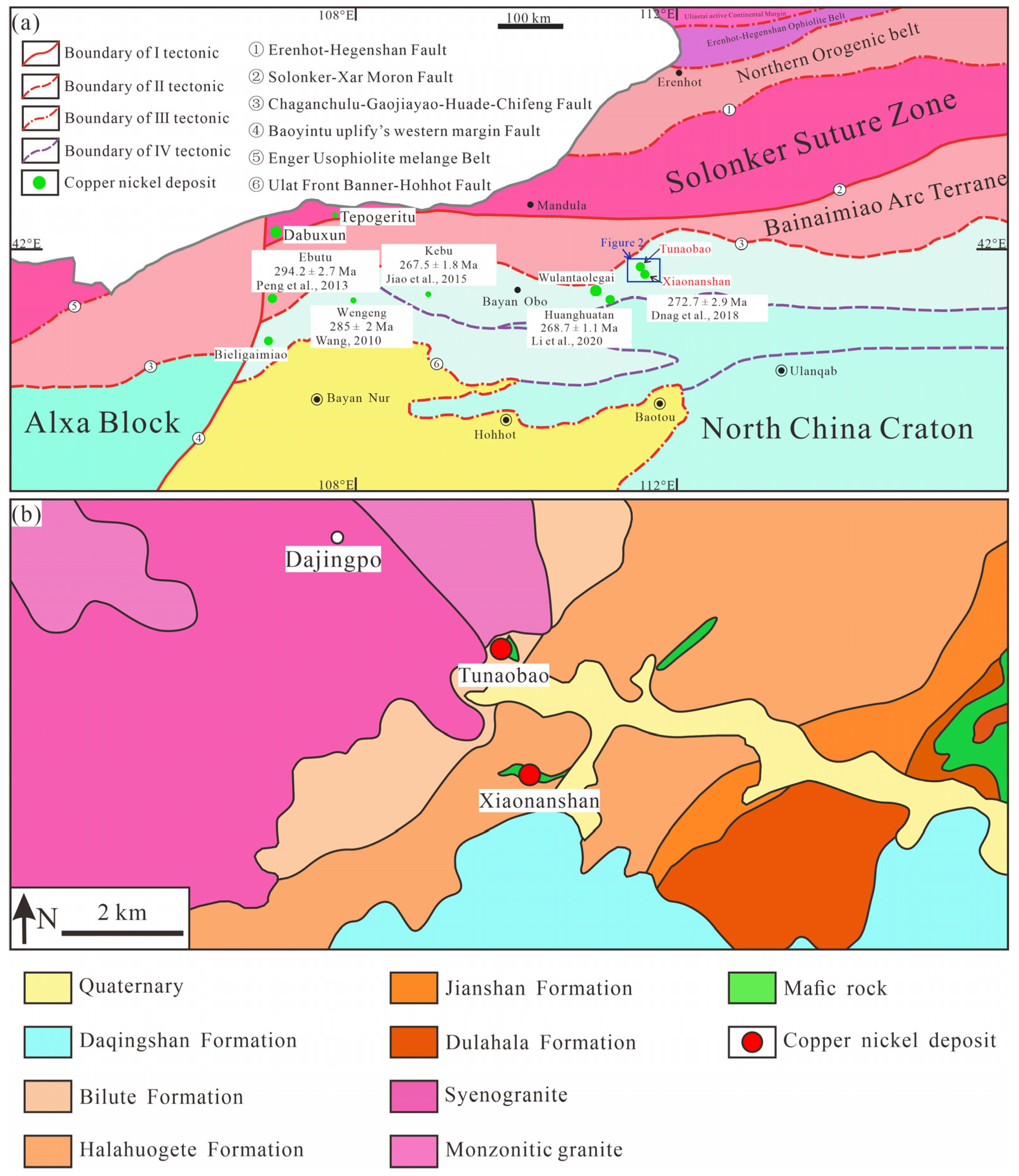
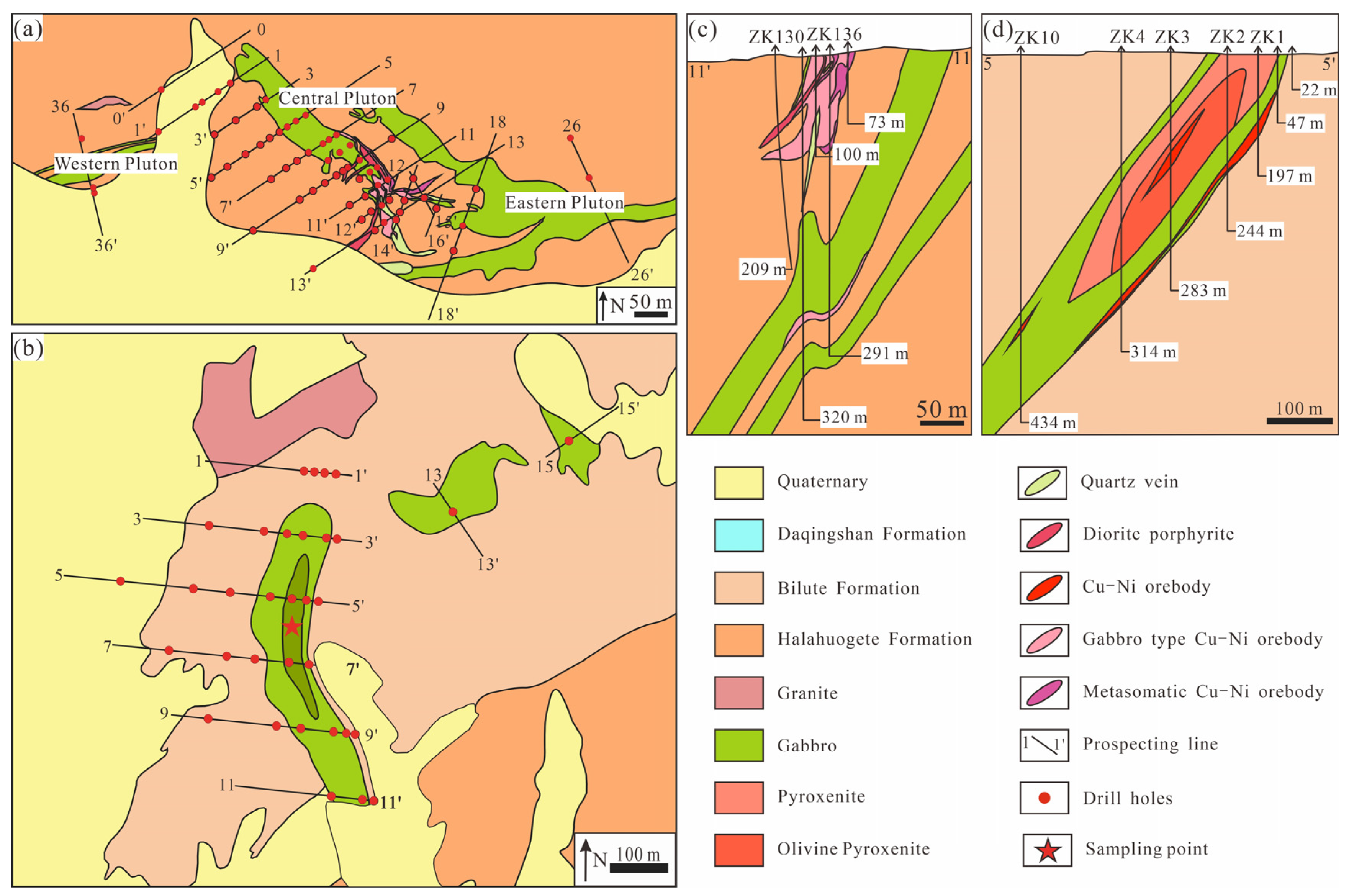
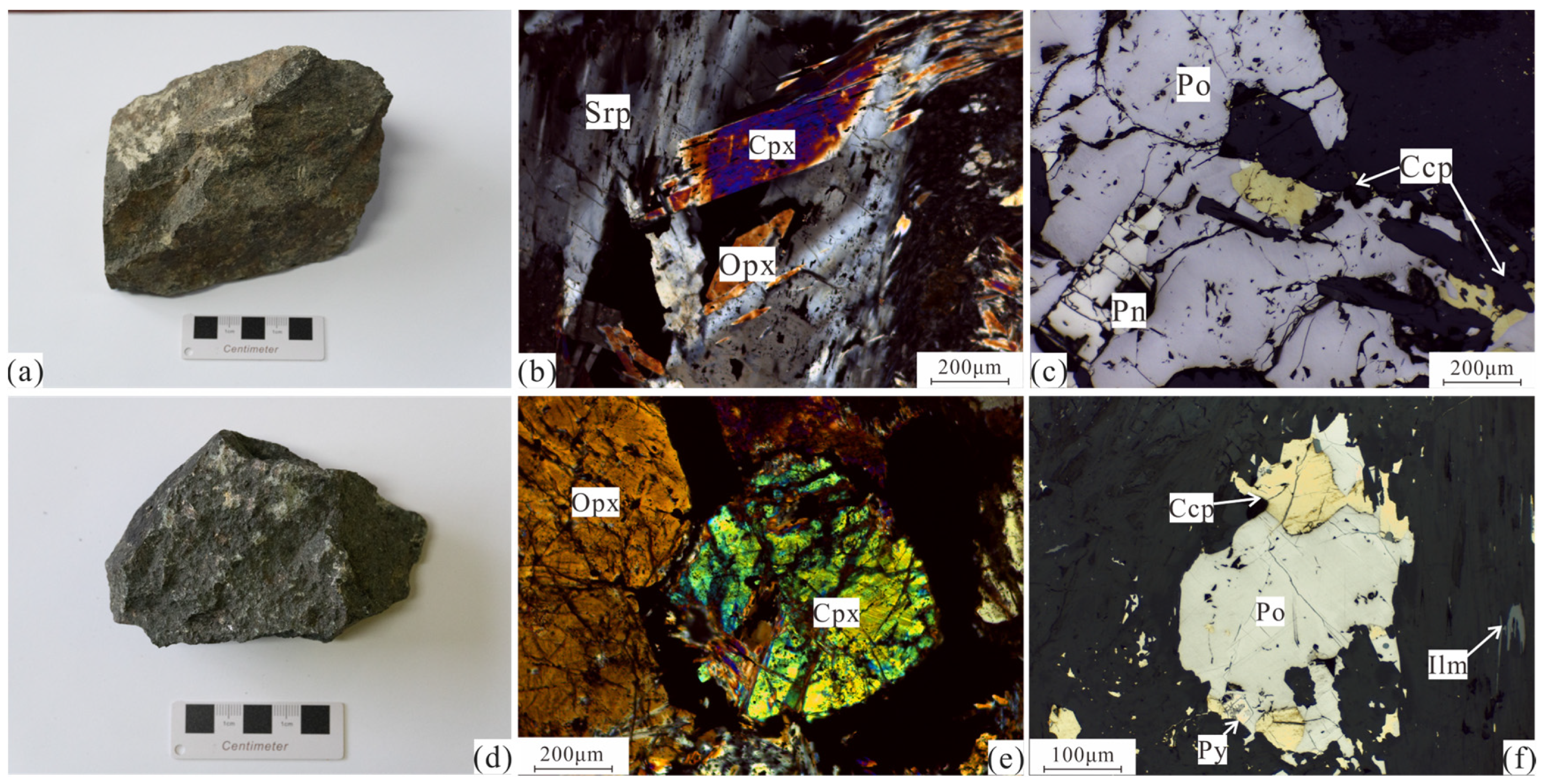



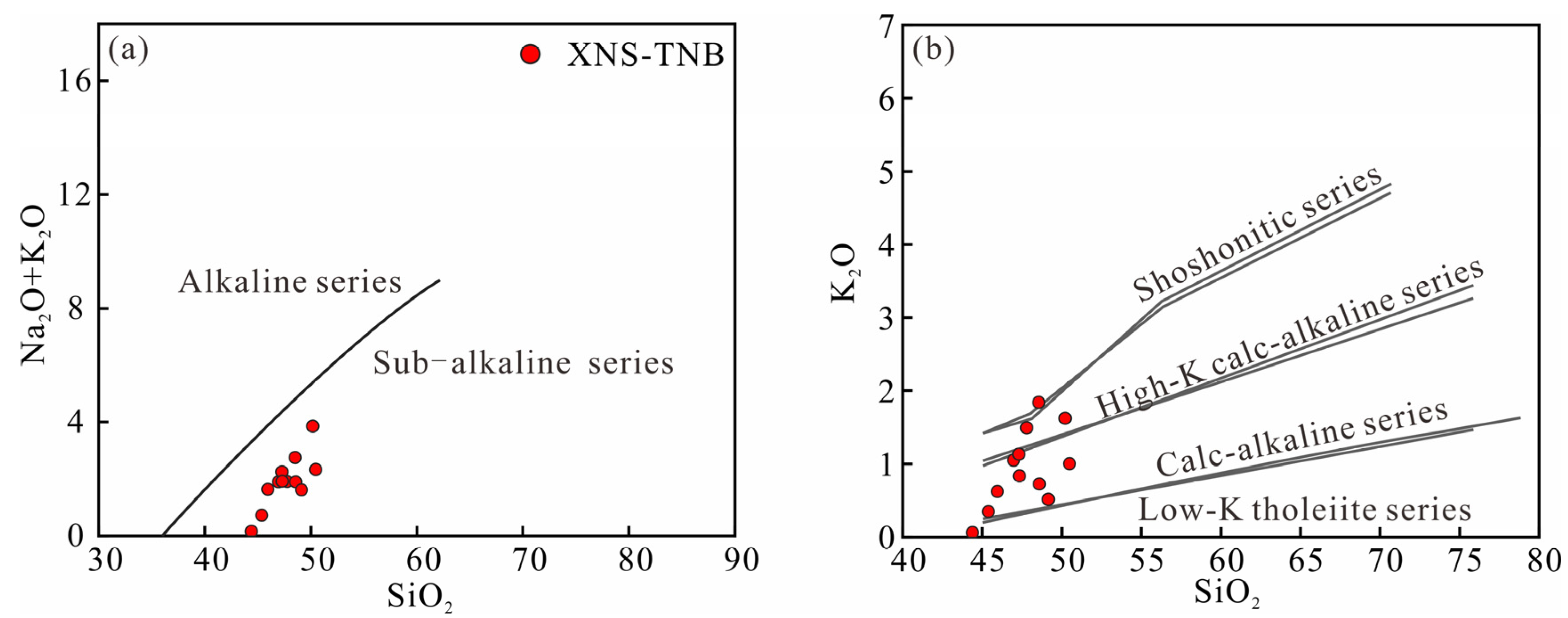
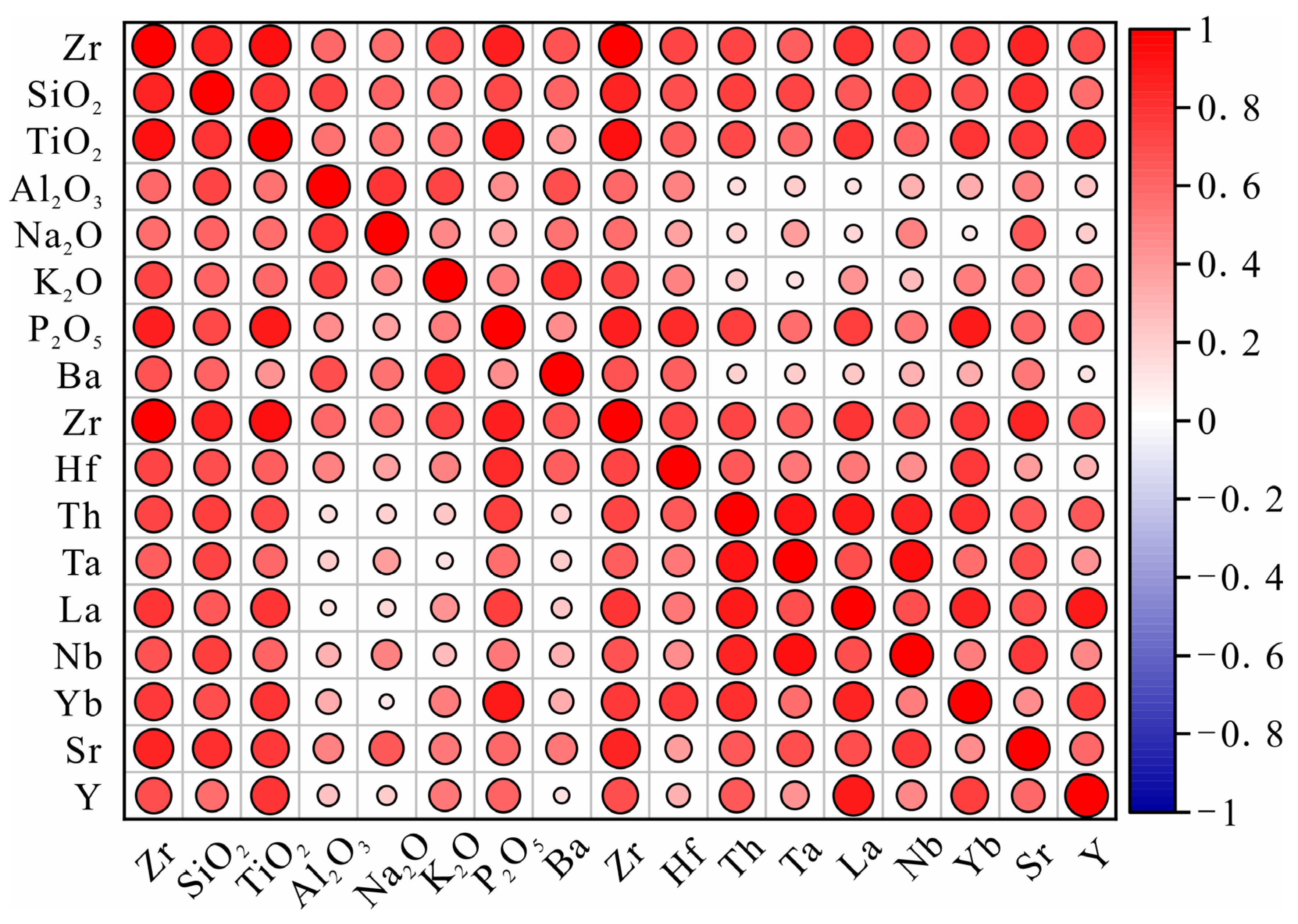
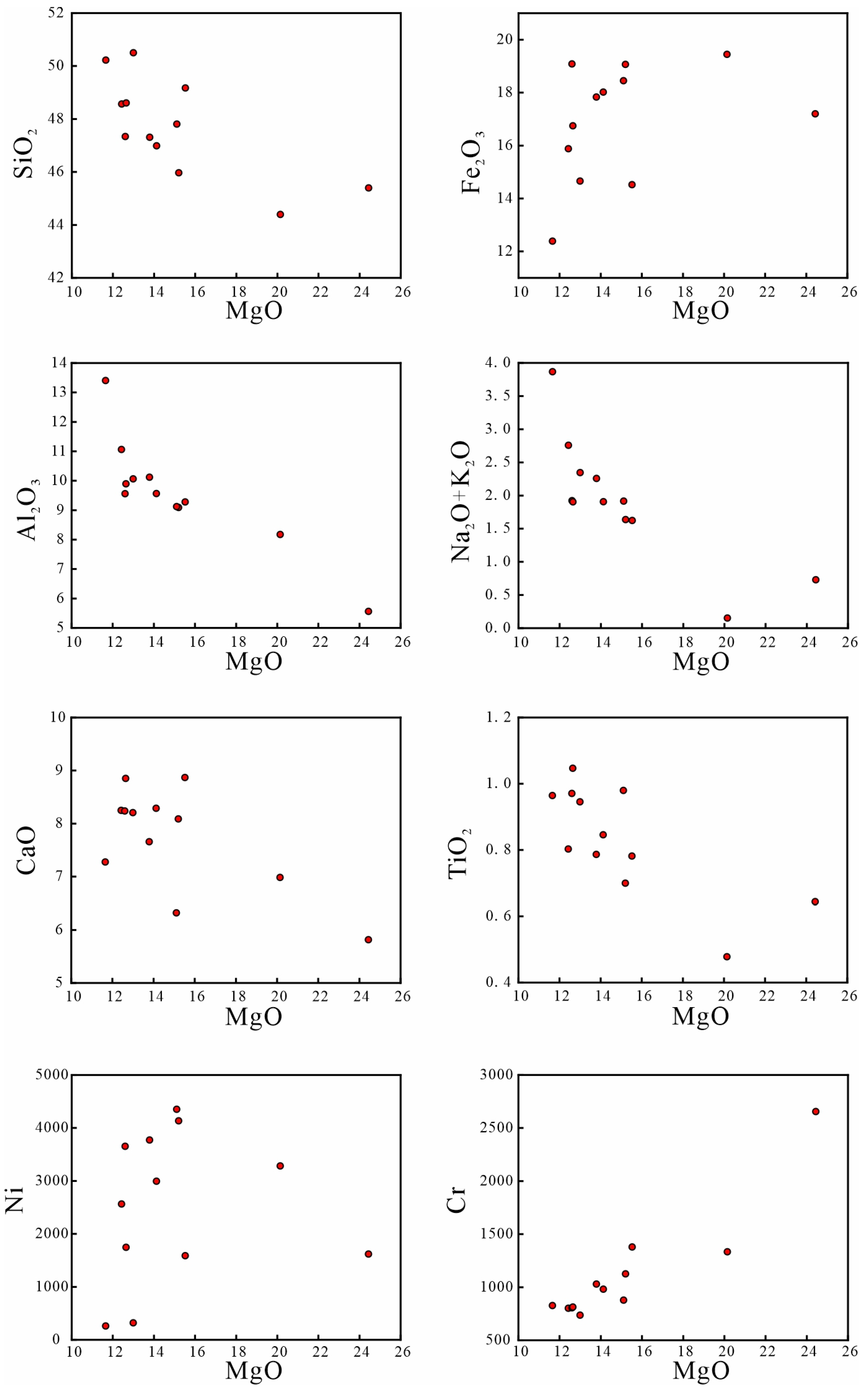
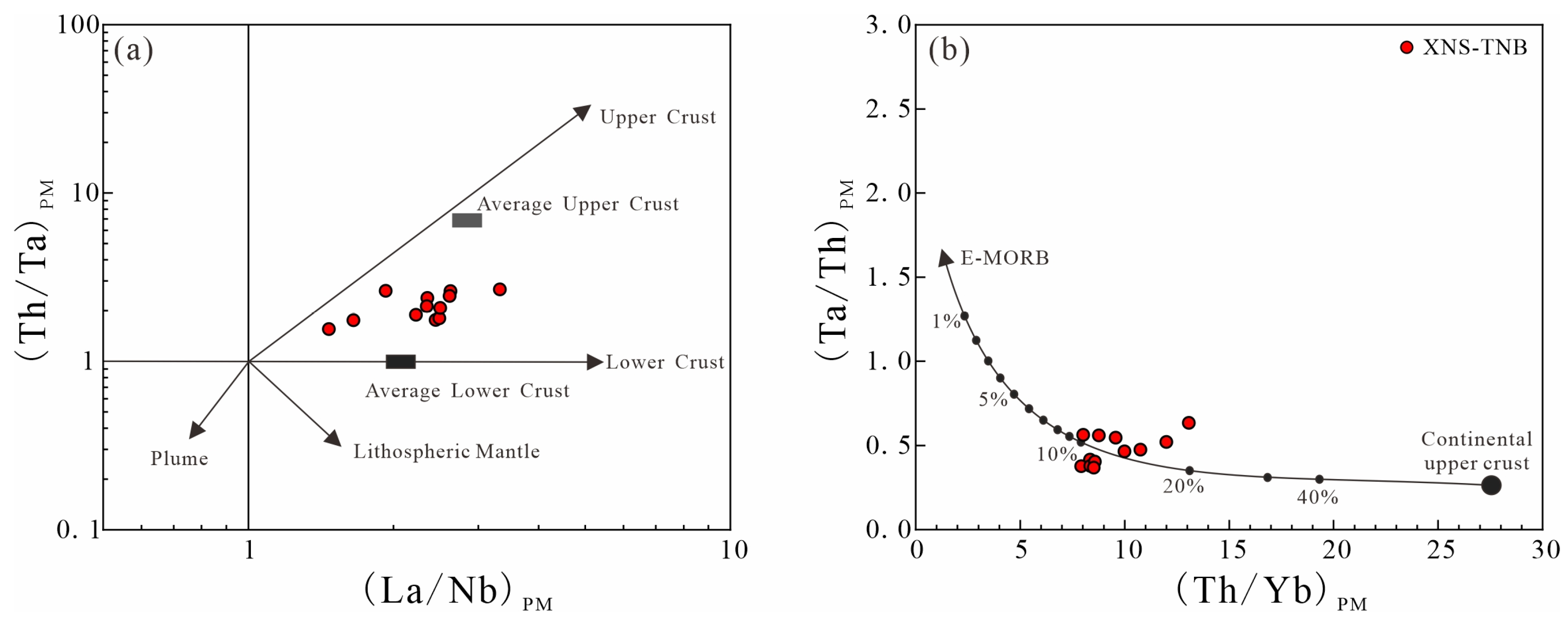
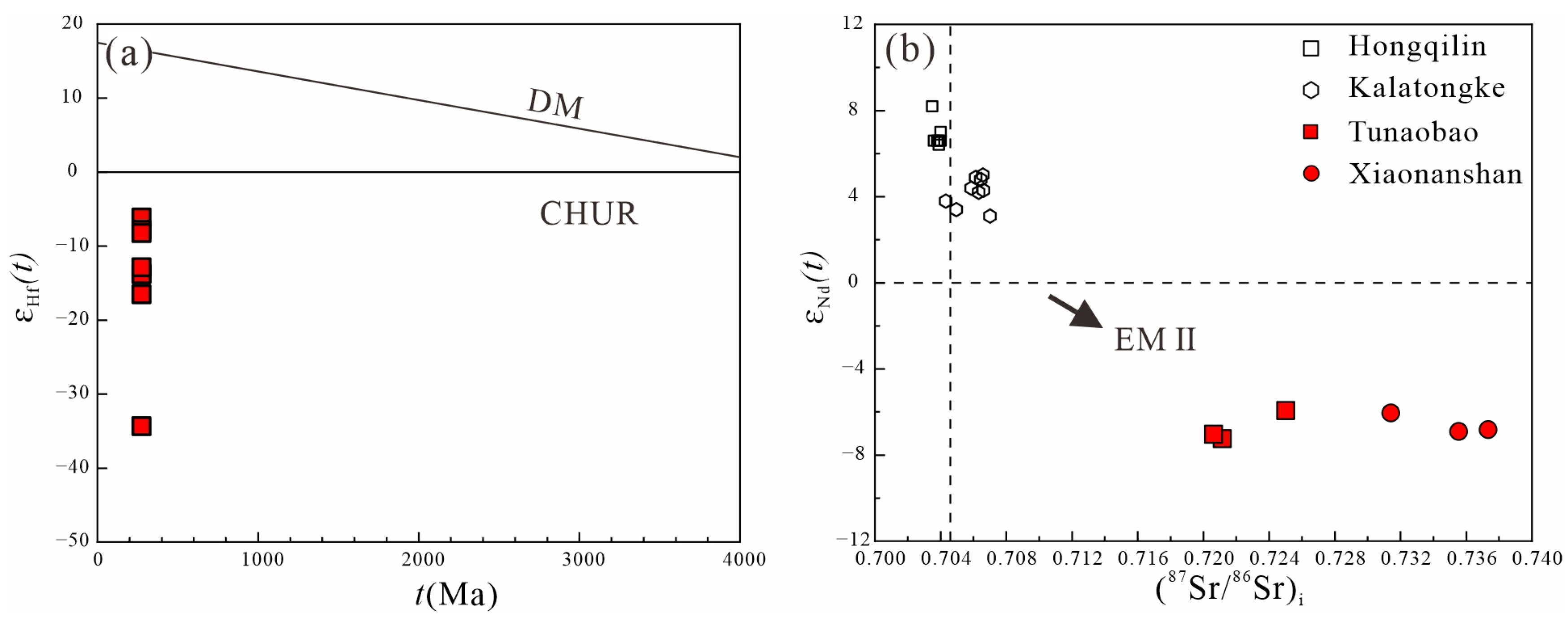
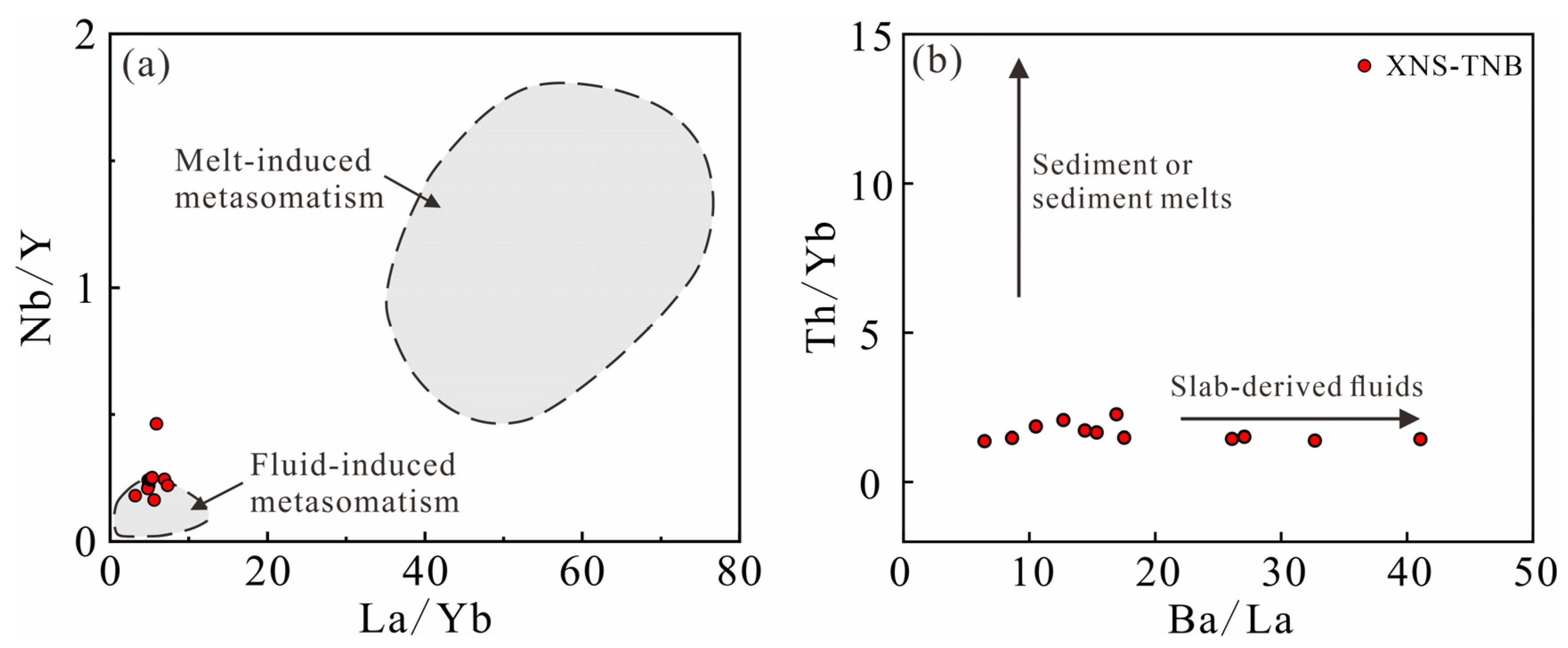

| Sample | Pb (ppm) | Th (ppm) | U (ppm) | Th/U | 207Pb/206Pb | ±1σ | 207Pb/235U | ±1σ | 206Pb/238U | ±1σ | 207Pb/235U | ±1σ | 206Pb/238U | ±1σ |
|---|---|---|---|---|---|---|---|---|---|---|---|---|---|---|
| 22TNB-1-1 | 27.47 | 210.3 | 572.7 | 0.37 | 0.0577 | 0.0024 | 0.3458 | 0.0149 | 0.0433 | 0.0007 | 301.6 | 11.27 | 273.0 | 4.08 |
| 22TNB-1-2 | 9.63 | 100.1 | 196.5 | 0.51 | 0.0522 | 0.0031 | 0.314 | 0.0197 | 0.0436 | 0.0009 | 277.2 | 15.25 | 275.3 | 5.44 |
| 22TNB-1-3 | 8.31 | 128.5 | 223.9 | 0.57 | 0.0569 | 0.0043 | 0.2413 | 0.0161 | 0.0317 | 0.0006 | 219.5 | 13.19 | 201.3 | 3.53 |
| 22TNB-1-5 | 11.80 | 102.6 | 243.1 | 0.42 | 0.0513 | 0.0026 | 0.312 | 0.0168 | 0.0441 | 0.0008 | 275.7 | 13.00 | 278.1 | 5.02 |
| 22TNB-1-6 | 52.82 | 57.6 | 85.35 | 0.67 | 0.1638 | 0.0044 | 11.07 | 0.2925 | 0.4921 | 0.009 | 2529 | 24.62 | 2580 | 38.77 |
| 22TNB-1-7 | 278.2 | 284.3 | 583.4 | 0.49 | 0.1305 | 0.0031 | 7.456 | 0.2033 | 0.4126 | 0.0072 | 2168 | 24.42 | 2227 | 32.64 |
| 22TNB-1-8 | 30.34 | 304.7 | 604.2 | 0.50 | 0.0562 | 0.0021 | 0.3435 | 0.0139 | 0.0441 | 0.0007 | 299.8 | 10.52 | 278.0 | 4.39 |
| 22TNB-1-9 | 29.22 | 307 | 607.7 | 0.51 | 0.0554 | 0.0023 | 0.3275 | 0.0135 | 0.0435 | 0.0009 | 287.7 | 10.33 | 274.2 | 5.27 |
| 22TNB-1-10 | 89.63 | 125.9 | 166.8 | 0.75 | 0.1537 | 0.0047 | 8.925 | 0.2755 | 0.4199 | 0.0065 | 2330 | 28.19 | 2260 | 29.6 |
| 22TNB-1-11 | 34.06 | 197.1 | 400.7 | 0.49 | 0.0601 | 0.0025 | 0.63 | 0.0268 | 0.0759 | 0.0013 | 496.1 | 16.67 | 471.4 | 7.56 |
| 22TNB-1-12 | 45.84 | 87.56 | 259.2 | 0.34 | 0.079 | 0.0024 | 1.761 | 0.0581 | 0.1608 | 0.0029 | 1031 | 21.36 | 961.4 | 15.88 |
| 22TNB-1-13 | 34.01 | 202.6 | 412.3 | 0.49 | 0.0575 | 0.0023 | 0.5802 | 0.0231 | 0.0729 | 0.0011 | 464.6 | 14.85 | 453.8 | 6.42 |
| 22TNB-1-15 | 67.92 | 154.9 | 141.9 | 1.09 | 0.1204 | 0.0031 | 5.985 | 0.156 | 0.3593 | 0.0048 | 1974 | 22.68 | 1979 | 22.98 |
| 22TNB-1-16 | 54.32 | 211.5 | 276.1 | 0.77 | 0.0708 | 0.0022 | 1.649 | 0.0563 | 0.1681 | 0.0028 | 989.1 | 21.58 | 1002 | 15.46 |
| 22TNB-1-17 | 12.05 | 159 | 244.7 | 0.65 | 0.0518 | 0.0032 | 0.3188 | 0.0276 | 0.0438 | 0.001 | 281 | 21.26 | 276.5 | 6.15 |
| 22TNB-1-19 | 189.3 | 337.7 | 380.7 | 0.89 | 0.1314 | 0.0034 | 7.17 | 0.2035 | 0.3942 | 0.0073 | 2133 | 25.29 | 2142 | 33.7 |
| 22TNB-1-21 | 10.63 | 122.9 | 257.9 | 0.48 | 0.0536 | 0.0029 | 0.2708 | 0.0142 | 0.0369 | 0.0006 | 243.4 | 11.37 | 233.7 | 3.97 |
| 22TNB-1-24 | 282.4 | 26.75 | 803.1 | 0.03 | 0.1182 | 0.0030 | 5.482 | 0.1445 | 0.3356 | 0.0055 | 1898 | 22.65 | 1865 | 26.78 |
| 22TNB-1-26 | 8.13 | 89.75 | 163.7 | 0.55 | 0.0545 | 0.0044 | 0.3227 | 0.0259 | 0.0436 | 0.0009 | 284 | 19.89 | 275.1 | 5.32 |
| 22TNB-1-27 | 11.96 | 103.9 | 241.4 | 0.43 | 0.0576 | 0.0037 | 0.3466 | 0.0216 | 0.0441 | 0.0008 | 302.2 | 16.29 | 278.2 | 4.98 |
| 22TNB-1-28 | 12.57 | 138.5 | 246.9 | 0.56 | 0.0556 | 0.003 | 0.3333 | 0.0177 | 0.0438 | 0.0008 | 292.1 | 13.48 | 276.2 | 5.23 |
| 22TNB-1-29 | 268.2 | 290.4 | 1042.9 | 0.28 | 0.0832 | 0.002 | 2.699 | 0.07 | 0.2351 | 0.0031 | 1328 | 19.22 | 1361 | 16.17 |
| 22TNB-1-31 | 12.23 | 170.8 | 232.1 | 0.74 | 0.0539 | 0.003 | 0.322 | 0.0177 | 0.0437 | 0.0008 | 283.5 | 13.63 | 275.6 | 4.74 |
| 22TNB-1-35 | 34.4 | 376.7 | 681.5 | 0.55 | 0.0541 | 0.0021 | 0.3289 | 0.014 | 0.0439 | 0.0008 | 288.7 | 10.71 | 276.9 | 4.74 |
| 22TNB-1-37 | 10.33 | 203.5 | 143.7 | 1.42 | 0.0583 | 0.0035 | 0.4099 | 0.0259 | 0.0508 | 0.0009 | 348.8 | 18.68 | 319.3 | 5.68 |
| 22TNB-1-38 | 47.42 | 327.8 | 596.4 | 0.55 | 0.0556 | 0.0024 | 0.5259 | 0.0229 | 0.0684 | 0.0012 | 429.1 | 15.21 | 426.5 | 7.35 |
| 22TNB-1-39 | 12.79 | 160.4 | 245.3 | 0.65 | 0.0487 | 0.0028 | 0.2952 | 0.018 | 0.0435 | 0.0008 | 262.6 | 14.08 | 274.8 | 4.98 |
| 22TNB-1-40 | 28.46 | 327.4 | 313.2 | 1.05 | 0.0559 | 0.003 | 0.5297 | 0.0273 | 0.0685 | 0.001 | 431.6 | 18.11 | 427.1 | 6.13 |
| Sitenumber | T(Ma) | 176Yb/177Hf | 176Lu/177Hf | 176Hf/177Hf | ±2σ | TDM1(Ga) | εHf(t)DM |
|---|---|---|---|---|---|---|---|
| TNB-17 | 276 | 0.07658 | 0.001187 | 0.2829 | 0.000022 | 0.52 | −6.16 |
| TNB-2 | 275 | 0.1118 | 0.001787 | 0.2827 | 0.000026 | 0.82 | −13.74 |
| TNB-26 | 275 | 0.1187 | 0.002004 | 0.2827 | 0.000032 | 0.83 | −13.83 |
| TNB-27 | 278 | 0.1204 | 0.001940 | 0.2827 | 0.000035 | 0.79 | −12.84 |
| TNB-31 | 275 | 0.1280 | 0.002194 | 0.2828 | 0.000036 | 0.59 | −7.83 |
| TNB-39 | 275 | 0.1583 | 0.002636 | 0.2821 | 0.000033 | 1.65 | −34.34 |
| TNB-5 | 278 | 0.09756 | 0.001612 | 0.2826 | 0.000023 | 0.92 | −16.44 |
| TNB-8 | 278 | 0.1513 | 0.002266 | 0.2828 | 0.000027 | 0.61 | −8.20 |
| Sample | 20XNS-13 | 20XNS-3 | 20XNS-10 | 20XNS-17 | 20XNS-6 | 20TNB-10 | 20TNB-2 | 20TNB-9 | 20TNB-5 | 20XNS-11 | 20TNB-6 | 22TNB-1 |
|---|---|---|---|---|---|---|---|---|---|---|---|---|
| Rock | Gabbro | Altered Gabbro | Gabbro | Gabbro | Gabbro | Gabbro | Gabbro | Gabbro | Gabbro | Gabbro | Gabbro | Altered Gabbro |
| SiO2 | 48.57 | 44.39 | 46.98 | 47.31 | 45.96 | 50.50 | 47.81 | 47.34 | 48.60 | 50.23 | 49.17 | 45.39 |
| TiO2 | 0.80 | 0.48 | 0.85 | 0.79 | 0.70 | 0.95 | 0.98 | 0.97 | 1.05 | 0.96 | 0.78 | 0.64 |
| Al2O3 | 11.06 | 8.17 | 9.56 | 10.12 | 9.09 | 10.06 | 9.12 | 9.56 | 9.90 | 13.41 | 9.28 | 5.56 |
| Fe2O3 | 15.88 | 19.45 | 18.02 | 17.83 | 19.06 | 14.65 | 18.45 | 19.08 | 16.74 | 12.39 | 14.52 | 17.20 |
| MnO | 0.16 | 0.18 | 0.18 | 0.17 | 0.17 | 0.18 | 0.20 | 0.18 | 0.19 | 0.14 | 0.16 | 0.16 |
| MgO | 12.43 | 20.15 | 14.13 | 13.79 | 15.21 | 13.00 | 15.11 | 12.60 | 12.65 | 11.65 | 15.53 | 24.44 |
| CaO | 8.25 | 6.98 | 8.29 | 7.66 | 8.09 | 8.21 | 6.32 | 8.24 | 8.85 | 7.27 | 8.87 | 5.81 |
| Na2O | 0.92 | 0.09 | 0.86 | 1.12 | 1.02 | 1.35 | 0.42 | 1.09 | 1.18 | 2.24 | 1.11 | 0.38 |
| K2O | 1.84 | 0.06 | 1.05 | 1.13 | 0.62 | 1.00 | 1.49 | 0.84 | 0.72 | 1.62 | 0.51 | 0.35 |
| P2O5 | 0.09 | 0.05 | 0.09 | 0.08 | 0.08 | 0.10 | 0.10 | 0.10 | 0.12 | 0.08 | 0.06 | 0.06 |
| TOTAL | 100.00 | 100.00 | 100.00 | 100.00 | 100.00 | 100.00 | 100.00 | 100.00 | 100.00 | 100.00 | 100.00 | 100.00 |
| LOI | 3.01 | 5.12 | 3.12 | 3.02 | 3.06 | 1.12 | 4.52 | 3.24 | 1.65 | 3.76 | 2.30 | 4.49 |
| Mg# | 37.67 | 44.43 | 37.70 | 37.38 | 38.11 | 40.64 | 38.74 | 33.77 | 36.83 | 42.07 | 45.22 | 52.31 |
| Li | 44 | 25 | 49 | 56 | 56 | 24 | 38 | 22 | 24 | 42 | 14 | 10 |
| Be | 0.4 | 1.3 | 0.5 | 0.5 | 0.4 | 0.6 | 0.9 | 0.6 | 0.7 | 0.5 | 0.5 | 0.4 |
| Sc | 27 | 24 | 28 | 29 | 29 | 28 | 24 | 27 | 28 | 18 | 22 | 20 |
| V | 172 | 140 | 165 | 179 | 174 | 181 | 145 | 167 | 176 | 266 | 283 | 225 |
| Cr | 801 | 1333 | 981 | 1029 | 1126 | 737 | 878 | 805 | 813 | 827 | 1378 | 2655 |
| Co | 148 | 179 | 163 | 203 | 214 | 98 | 201 | 225 | 142 | 65 | 142 | 162 |
| Ni | 2563 | 3283 | 2995 | 3771 | 4135 | 320 | 4351 | 3653 | 1745 | 261 | 1588 | 1618 |
| Cu | 2174 | 1657 | 2883 | 1625 | 2652 | 231 | 1192 | 2012 | 1044 | 106 | 614 | 724 |
| Zn | 79 | 87 | 93 | 89 | 97 | 90 | 131 | 92 | 91 | 100 | 95 | 109 |
| Ga | 15 | 12 | 14 | 15 | 14 | 18 | 14 | 15 | 17 | 18 | 13 | 10 |
| Rb | 98 | 7 | 66 | 83 | 51 | 58 | 120 | 40 | 37 | 77 | 29 | 21 |
| Sr | 113 | 12 | 69 | 72 | 52 | 136 | 91 | 101 | 114 | 111 | 120 | 67 |
| Y | 14 | 10 | 14 | 14 | 13 | 17 | 23 | 15 | 17 | 16 | 15 | 13 |
| Zr | 74 | 41 | 68 | 64 | 59 | 77 | 71 | 72 | 76 | 69 | 62 | 54 |
| Nb | 3.4 | 1.7 | 3.1 | 3.0 | 2.8 | 7.8 | 3.7 | 3.7 | 4.2 | 4.0 | 3.7 | 2.9 |
| Mo | 0.3 | 0.3 | 0.3 | 0.4 | 0.4 | 0.3 | 0.4 | 0.9 | 0.4 | 0.8 | 0.7 | 0.4 |
| Cd | 0.5 | 0.3 | 0.7 | 0.5 | 0.7 | 0.3 | 1.6 | 0.7 | 0.5 | 0.1 | 0.3 | 0.2 |
| In | 0.1 | 0.1 | 0.1 | 0.1 | 0.1 | 0.1 | 0.1 | 0.1 | 0.1 | 0.1 | 0.1 | 0.1 |
| Cs | 5.3 | 1.6 | 5.0 | 7.1 | 5.6 | 9.8 | 24.1 | 8.6 | 6.6 | 1.5 | 5.4 | 4.9 |
| Ba | 314 | 21 | 206 | 194 | 123 | 187 | 102 | 135 | 137 | 207 | 101 | 73 |
| La | 7.6 | 3.2 | 7.9 | 7.2 | 7.0 | 11.0 | 11.8 | 8.8 | 9.5 | 6.3 | 7.9 | 7.0 |
| Ce | 17 | 7 | 17 | 16 | 15 | 23 | 28 | 19 | 22 | 16 | 17 | 15 |
| Pr | 2.4 | 1.0 | 2.5 | 2.3 | 2.2 | 3.2 | 3.9 | 2.8 | 3.1 | 1.9 | 2.0 | 1.8 |
| Nd | 10 | 4 | 10 | 10 | 9 | 13 | 16 | 12 | 13 | 8 | 9 | 8 |
| Sm | 2.8 | 1.6 | 3.0 | 2.8 | 2.6 | 3.6 | 4.4 | 3.1 | 3.6 | 2.3 | 2.3 | 2.0 |
| Eu | 1.0 | 0.4 | 0.9 | 0.9 | 0.8 | 1.1 | 1.0 | 0.9 | 1.1 | 0.8 | 0.7 | 0.6 |
| Gd | 2.5 | 1.5 | 2.7 | 2.5 | 2.4 | 3.1 | 3.9 | 2.8 | 3.2 | 2.8 | 2.6 | 2.3 |
| Tb | 0.5 | 0.3 | 0.5 | 0.5 | 0.5 | 0.6 | 0.8 | 0.6 | 0.6 | 0.5 | 0.4 | 0.4 |
| Dy | 3.0 | 2.1 | 3.2 | 3.1 | 3.0 | 3.7 | 4.5 | 3.4 | 3.8 | 2.7 | 2.5 | 2.1 |
| Ho | 0.6 | 0.4 | 0.6 | 0.6 | 0.6 | 0.7 | 0.9 | 0.6 | 0.7 | 0.5 | 0.5 | 0.4 |
| Er | 1.6 | 1.1 | 1.6 | 1.6 | 1.5 | 1.9 | 2.3 | 1.8 | 1.9 | 1.4 | 1.3 | 1.1 |
| Tm | 0.3 | 0.2 | 0.3 | 0.3 | 0.2 | 0.3 | 0.4 | 0.3 | 0.3 | 0.2 | 0.2 | 0.2 |
| Yb | 1.6 | 1.0 | 1.6 | 1.5 | 1.5 | 1.9 | 2.1 | 1.7 | 1.8 | 1.2 | 1.1 | 0.9 |
| Lu | 0.2 | 0.2 | 0.2 | 0.2 | 0.2 | 0.3 | 0.3 | 0.3 | 0.3 | 0.2 | 0.2 | 0.1 |
| Hf | 2.5 | 1.5 | 2.5 | 2.5 | 2.4 | 2.7 | 2.1 | 2.4 | 2.6 | 1.8 | 1.6 | 1.4 |
| Ta | 0.5 | 0.3 | 0.4 | 0.6 | 0.4 | 1.3 | 0.6 | 0.8 | 0.7 | 0.4 | 0.6 | 0.4 |
| Pb | 6.0 | 3.2 | 6.5 | 7.1 | 12.8 | 26.2 | 29.9 | 25.4 | 24.5 | 2.7 | 11.2 | 5.9 |
| Bi | 1.9 | 1.5 | 2.3 | 2.6 | 2.9 | 0.4 | 5.4 | 3.8 | 1.7 | 0.4 | 1.0 | 0.5 |
| Th | 2.3 | 1.4 | 2.3 | 2.2 | 2.2 | 4.2 | 3.1 | 2.8 | 3.2 | 1.6 | 2.4 | 1.8 |
| U | 0.4 | 0.2 | 0.5 | 0.4 | 0.5 | 0.7 | 0.6 | 0.6 | 0.7 | 0.5 | 0.4 | 0.4 |
| ΣREE | 64.96 | 33.79 | 67.01 | 63.34 | 60.28 | 84.99 | 103.26 | 73.29 | 81.39 | 60.81 | 62.60 | 54.88 |
| (La/Yb)N | 3.47 | 2.30 | 3.48 | 3.53 | 3.45 | 4.24 | 4.01 | 3.67 | 3.70 | 3.84 | 4.96 | 5.26 |
| (La/Sm)N | 1.75 | 1.32 | 1.71 | 1.63 | 1.74 | 2.00 | 1.75 | 1.80 | 1.70 | 1.75 | 2.28 | 2.28 |
| (Gd/Lu)N | 1.35 | 1.19 | 1.38 | 1.29 | 1.36 | 1.26 | 1.42 | 1.31 | 1.33 | 2.07 | 1.94 | 2.04 |
| δEu | 1.10 | 0.76 | 0.98 | 1.04 | 0.95 | 1.00 | 0.76 | 0.94 | 0.98 | 0.91 | 0.91 | 0.82 |
| Sample | Rb (ppm) | Sr (ppm) | 87Rb/86Sr | (87Sr/86Sr) | ±2σ | T(Ma) | (87Sr/86Sr)i | Sm (ppm) | Nd (ppm) | 147Sm/144Nd | 143Nd/144Nd | (143Nd/144Nd)i | εNd(t) | TDM(Ga) | εSr(t) |
|---|---|---|---|---|---|---|---|---|---|---|---|---|---|---|---|
| 20XNS-5 | 48.76 | 130.2 | 1.083 | 0.7356 | 0.000007 | 275.5 | 0.7314 | 3.10 | 10.72 | 0.1747 | 0.5123 | 0.5120 | −6.04 | 3.34 | 386.3 |
| 20XNS-7 | 60.29 | 79.93 | 2.182 | 0.7458 | 0.000006 | 275.5 | 0.7373 | 3.35 | 12.35 | 0.1641 | 0.5122 | 0.5119 | −6.82 | 2.81 | 469.7 |
| 20XNS-16 | 46.81 | 81.59 | 1.660 | 0.7420 | 0.000006 | 275.5 | 0.7355 | 3.04 | 10.32 | 0.1780 | 0.5123 | 0.5119 | −6.91 | 3.80 | 444.5 |
| 20TNB-3 | 57.07 | 90.52 | 1.824 | 0.7321 | 0.000007 | 275.5 | 0.7249 | 2.82 | 10.63 | 0.1604 | 0.5123 | 0.5120 | −5.92 | 2.51 | 294.9 |
| 20TNB-7 | 28.93 | 104.2 | 0.8035 | 0.7238 | 0.000007 | 275.5 | 0.7206 | 2.61 | 8.95 | 0.1763 | 0.5122 | 0.5119 | −7.03 | 3.68 | 233.2 |
| 20TNB-11 | 30.83 | 101.2 | 0.8815 | 0.7246 | 0.000009 | 275.5 | 0.7211 | 2.74 | 9.93 | 0.1668 | 0.5122 | 0.5119 | −7.24 | 3.02 | 240.6 |
| Sample | Sulfide Mineral | δ33Sv-CDT | δ34Sv-CDT | Δ33S |
|---|---|---|---|---|
| 20XNS-1#1 | Chalcopyrite | 4.9 | 10.5 | −0.5481 |
| 20XNS-1#1 | Pyrrhotite | 3.7 | 7.6 | −0.2143 |
| 20XNS-1#1 | Pyrrhotite | 4.2 | 8.1 | 0.0291 |
| 20XNS-1#2 | Chalcopyrite | 5.4 | 10.9 | −0.1835 |
| 20XNS-1#2 | Chalcopyrite | 5.4 | 10.2 | 0.1364 |
| 20XNS-1#2 | Pyrrhotite | 2.4 | 7.8 | −1.682 |
| 20XNS-1#2 | Pyrite | 5.3 | 10.8 | −0.2571 |
| 20XNS-1#2 | Pyrite | 5.9 | 11.4 | 0.03385 |
| 20XNS-1#2 | Pyrite | 5.5 | 11.2 | −0.2735 |
| 20XNS-10#1 | Pyrrhotite | 0.9 | 4.9 | −1.603 |
| 20XNS-10#1 | Pyrrhotite | 1.1 | 4.9 | −1.414 |
| 20XNS-10#1 | Pyrite | 2.9 | 5.6 | −0.024 |
| 20XNS-10#1 | Pyrite | 3.1 | 5.8 | 0.05875 |
| 20XNS-10#2 | Chalcopyrite | 4.9 | 6.3 | 1.716 |
| 20XNS-10#2 | Chalcopyrite | 4.1 | 6.2 | 0.8764 |
| 20XNS-10#2 | Chalcopyrite | 3.8 | 6.2 | 0.6625 |
| 20XNS-10#2 | Pyrrhotite | 1.3 | 4.6 | −1.058 |
| 20XNS-10#2 | Pyrite | 3.1 | 5.6 | 0.2157 |
| 20XNS-10#2 | Pyrite | 2.8 | 5.4 | 0.019 |
| Δ33 S = δ33 S − 1000 × [(1 + δ34 S/1000) 0.515 − 1] | ||||
Disclaimer/Publisher’s Note: The statements, opinions and data contained in all publications are solely those of the individual author(s) and contributor(s) and not of MDPI and/or the editor(s). MDPI and/or the editor(s) disclaim responsibility for any injury to people or property resulting from any ideas, methods, instructions or products referred to in the content. |
© 2024 by the authors. Licensee MDPI, Basel, Switzerland. This article is an open access article distributed under the terms and conditions of the Creative Commons Attribution (CC BY) license (https://creativecommons.org/licenses/by/4.0/).
Share and Cite
Bai, G.; Jiao, J.; Zheng, X.; Ma, Y.; Gao, C. The Formation Age and Magma Source of the Xiaonanshan–Tunaobao Cu-Ni-PGE Deposit in the Northern Margin of the North China Craton. Minerals 2024, 14, 733. https://doi.org/10.3390/min14070733
Bai G, Jiao J, Zheng X, Ma Y, Gao C. The Formation Age and Magma Source of the Xiaonanshan–Tunaobao Cu-Ni-PGE Deposit in the Northern Margin of the North China Craton. Minerals. 2024; 14(7):733. https://doi.org/10.3390/min14070733
Chicago/Turabian StyleBai, Guanlin, Jiangang Jiao, Xiaotong Zheng, Yunfei Ma, and Chao Gao. 2024. "The Formation Age and Magma Source of the Xiaonanshan–Tunaobao Cu-Ni-PGE Deposit in the Northern Margin of the North China Craton" Minerals 14, no. 7: 733. https://doi.org/10.3390/min14070733




